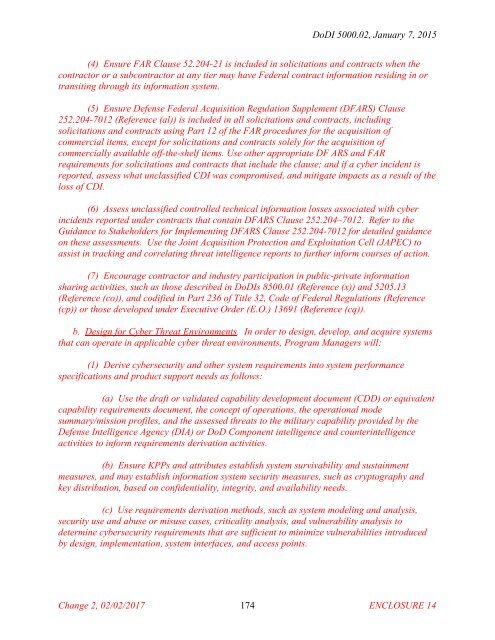Department of Defense INSTRUCTION
x9tnk
x9tnk
You also want an ePaper? Increase the reach of your titles
YUMPU automatically turns print PDFs into web optimized ePapers that Google loves.
DoDI 5000.02, January 7, 2015<br />
(4) Ensure FAR Clause 52.204-21 is included in solicitations and contracts when the<br />
contractor or a subcontractor at any tier may have Federal contract information residing in or<br />
transiting through its information system.<br />
(5) Ensure <strong>Defense</strong> Federal Acquisition Regulation Supplement (DFARS) Clause<br />
252.204-7012 (Reference (al)) is included in all solicitations and contracts, including<br />
solicitations and contracts using Part 12 <strong>of</strong> the FAR procedures for the acquisition <strong>of</strong><br />
commercial items, except for solicitations and contracts solely for the acquisition <strong>of</strong><br />
commercially available <strong>of</strong>f-the-shelf items. Use other appropriate DF ARS and FAR<br />
requirements for solicitations and contracts that include the clause; and if a cyber incident is<br />
reported, assess what unclassified CDI was compromised, and mitigate impacts as a result <strong>of</strong> the<br />
loss <strong>of</strong> CDI.<br />
(6) Assess unclassified controlled technical information losses associated with cyber<br />
incidents reported under contracts that contain DFARS Clause 252.204–7012. Refer to the<br />
Guidance to Stakeholders for Implementing DFARS Clause 252.204-7012 for detailed guidance<br />
on these assessments. Use the Joint Acquisition Protection and Exploitation Cell (JAPEC) to<br />
assist in tracking and correlating threat intelligence reports to further inform courses <strong>of</strong> action.<br />
(7) Encourage contractor and industry participation in public-private information<br />
sharing activities, such as those described in DoDIs 8500.01 (Reference (x)) and 5205.13<br />
(Reference (co)), and codified in Part 236 <strong>of</strong> Title 32, Code <strong>of</strong> Federal Regulations (Reference<br />
(cp)) or those developed under Executive Order (E.O.) 13691 (Reference (cq)).<br />
b. Design for Cyber Threat Environments. In order to design, develop, and acquire systems<br />
that can operate in applicable cyber threat environments, Program Managers will:<br />
(1) Derive cybersecurity and other system requirements into system performance<br />
specifications and product support needs as follows:<br />
(a) Use the draft or validated capability development document (CDD) or equivalent<br />
capability requirements document, the concept <strong>of</strong> operations, the operational mode<br />
summary/mission pr<strong>of</strong>iles, and the assessed threats to the military capability provided by the<br />
<strong>Defense</strong> Intelligence Agency (DIA) or DoD Component intelligence and counterintelligence<br />
activities to inform requirements derivation activities.<br />
(b) Ensure KPPs and attributes establish system survivability and sustainment<br />
measures, and may establish information system security measures, such as cryptography and<br />
key distribution, based on confidentiality, integrity, and availability needs.<br />
(c) Use requirements derivation methods, such as system modeling and analysis,<br />
security use and abuse or misuse cases, criticality analysis, and vulnerability analysis to<br />
determine cybersecurity requirements that are sufficient to minimize vulnerabilities introduced<br />
by design, implementation, system interfaces, and access points.<br />
Change 2, 02/02/2017 174<br />
ENCLOSURE 14


